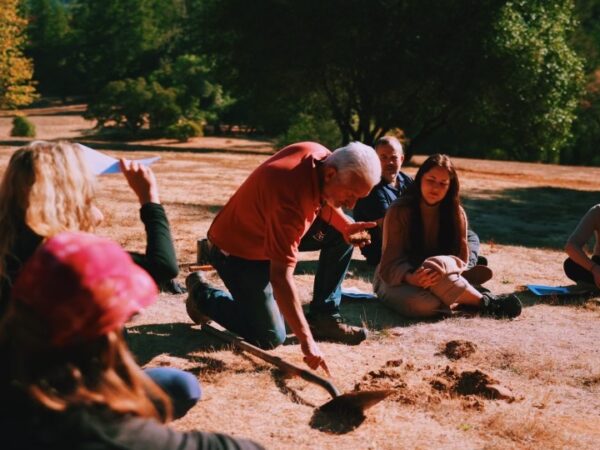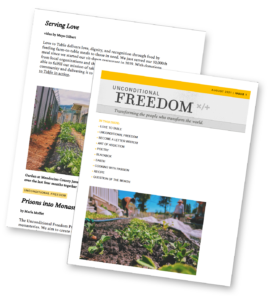by Bob Wilms
On October 15th, at the tail-end of a long dry season, we convened a dream team of experts in water and soil ecology to develop a restoration plan for the Land’s hydrological cycle and soil health. The group walked down the dry, desolate, creek bed of the once fertile Navarro River. The blistering hot, bleached white river rocks and dried out aquatic snail shells littered the river bed. We looked around, parched, feeling the air’s dryness, and talked about what we could do to change this as we continued our tour from meadow to garden to riparian forest.
The conference group consisted of Brock Dolman from the Occidental School of Arts and Ecology’s Water Institute, Linda Macalwee from the Mendocino County Resource Conservation District and the environmental consulting firm Punuske and Chatham, Elizabeth and Paul from Singing Frogs Farm, and soil scientist and advocate, Ray Archuleta, from the movie Kiss the Ground.
We looked at mitigating road erosion to prevent sediment from dumping into the river, collecting rainwater, setting up gray water systems to water our trees in the summer, and how we could secure grant funding to create more water storage, so that we wouldn’t have to pull water out of the ground or river.
Day two started off with Ray leading the group in an infiltration test of the soil in our upper meadow. He immediately noticed that we had been mowing our grasses close to the ground for fire prevention. Our thin layer of grass barely coated the soil, and he pointed out that the lack of structure to the grass meant that when it rains at a high velocity of 20 mph, those raindrops end up dispersing the soil and casting it downhill. With 75% of the soil nutrient in the top 2-3” of the soil, losing your top soil to erosion has a huge impact.
There was a moment in the garden later in the day when the Land staff was all sitting together at a table under live oaks, and we realized that all of these experts are here to help. Anytime they shared what’s possible with our soil, introducing shrubs and bushes on the property to make homes for animals, growing trees and inviting microclimates to cool down the soil and increase life, grazing sheep and goats, we got the chance to see our property with new eyes.
Thankfully, our conference did not end as it began. As Ray was finishing up his final presentation on soil health, it started to rain for the first time in six months, and it hasn’t stopped since.

 Get access to the monthly Rehumanization Magazine featuring contributors from the front lines of this effort—those living on Death Row, residents of the largest women’s prison in the world, renowned ecologists, the food insecure, and veteran correctional officers alike.
Get access to the monthly Rehumanization Magazine featuring contributors from the front lines of this effort—those living on Death Row, residents of the largest women’s prison in the world, renowned ecologists, the food insecure, and veteran correctional officers alike.